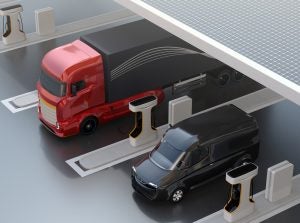 A new Environmental Defense Fund analysis finds that Texas’ successful emission reduction program could be even more powerful if it went electric — not just for reducing smog-forming nitrogen oxides and other local air pollutants, but for cutting greenhouse gas emissions and sparking job growth in the burgeoning electric vehicle industry.
A new Environmental Defense Fund analysis finds that Texas’ successful emission reduction program could be even more powerful if it went electric — not just for reducing smog-forming nitrogen oxides and other local air pollutants, but for cutting greenhouse gas emissions and sparking job growth in the burgeoning electric vehicle industry.
Administered by the Texas Commission on Environmental Quality, the Texas Emissions Reduction Plan provides financial incentives to reduce emissions from polluting vehicles and equipment. The bulk of TERP funding has been dedicated to quickening the replacement of larger diesel vehicles — medium- and heavy-duty vehicles. Since 2001, more than 35,000 TERP projects totaling over $1.3 billion in grants have reduced upwards of 183,000 tons of NOx, a major driver of the state’s air quality challenges.
Applying TERP’s annual grants to spur the electrification of Texas’ truck and bus fleets would decrease NOx emissions faster and for as little as one-third the cost per ton of NOx compared to TERP’s past grant programs.
Electric vehicles are ready to roll
The electric transformation that has been embraced by every major passenger vehicle manufacturer is gaining momentum in Texas and the international medium- and heavy-duty sector. Every major truck and bus manufacturer is developing at least one all-electric model or is part of an industry collaboration to bring zero-emission vehicles to market. A recent analysis found that at least 125 such models are in production, development or demonstration. In other words, the technology is ready to roll.
Electrifying Texas’ successful emission reduction program Share on XAdditionally, a new report from the Texas Advanced Energy Business Alliance found that jobs in the electric transportation sector are expected to double in Texas by 2024. The alliance proposes that more than 5,000 Texas companies and 400,000 workers would directly benefit from growth and increased demand in this sector.
TERP can multiply impact, unlock EV potential
Though electric vehicles cost less to run and maintain than diesel models, they cost more up front. That’s where focusing TERP grants on EV trucks and buses can be particularly powerful. And because EVs would achieve emission reductions for a third of the cost of other technologies like compressed natural gas, focusing TERP grants on them offers the most cost efficient pathway to achieve the program’s goals.
Consider just one scenario outlined in the report. EDF calculated the impact that one year of TERP funding could have on the up-front cost of electric replacements for transit buses and emission levels in the state.
Our analysis found that a single year of TERP funding could cut the cost of 1,875 transit buses by $120,000 each. Combined with lower annual maintenance costs (electric buses cost less to “fuel” and maintain per year than diesel buses), the up-front cost difference for each electric bus would be completely recouped within five years.
And the environmental payoff would be huge. Those electric buses would eliminate 1 million tons of greenhouse gas emissions and 477 tons of NOx emissions per year.
As of December 2020, TERP has nearly $2 billion in the bank — enough to double the program’s emission reductions to date. And because electric vehicles deliver NOx reductions at a much lower cost, EDF’s analysis suggests that investing the program’s existing $2 billion balance in electric vehicles would reduce two to three times as much NOx as new diesel or natural gas vehicles. Focusing its regular annual budget on electric trucks and buses would only magnify TERP’s potential.
Given the current economic climate, it’s clear the 87th Legislative Session will be focused on the budget, and we encourage the Legislature to honor H.B. 3745, which requires that all TERP funds be expended to reduce emissions from medium- and heavy-duty vehicles and other equipment until Texas’ air quality challenges are resolved. Money will indeed be tight at the Capitol in January. But taking advantage of the potential of electric trucks and buses won’t cost the state any new money. It’s an all-around win for our air, climate, economy and state budget.









